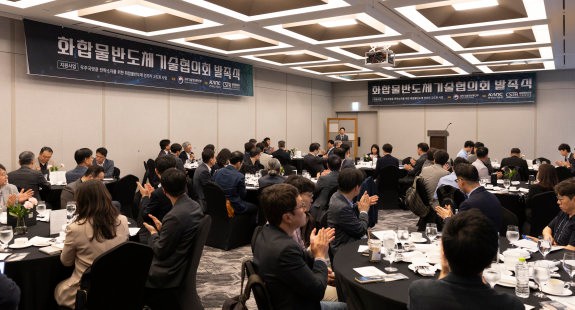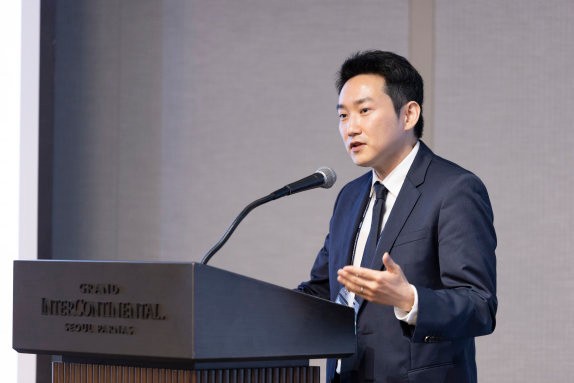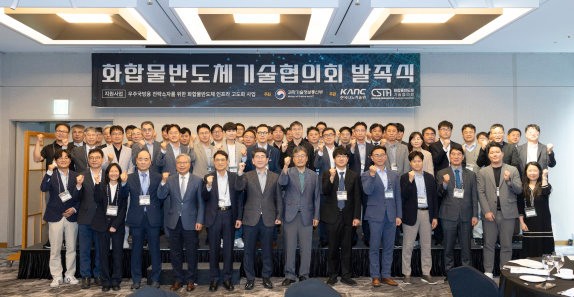NEWS & NOTICE
NEWS

NEWS & NOTICE

● Compound Semiconductors: A National Strategic Asset That Must Not Be Abandoned
● Government support is essential to foster related technologies, talent, and companies.
“Compound semiconductors are a strategic asset that must be nurtured for the advancement of South Korea.”
Yoon Eui-Joon, President of the National Academy of Engineering of Korea, made this statement during his congratulatory remarks at the launch ceremony of the Compound Semiconductor Technology Council (CSTA), held on May 20 at the Grand InterContinental Parnas in Gangnam, Seoul. Compound semiconductors are used in environments with high voltage and temperature, where traditional silicon semiconductors fall short.
 |
Hosted by the Ministry of Science and ICT(MSIT) and organized by the Korea Nano Technology Research Society and CSTA, the event was attended by over 60 industry, academic, and research representatives who discussed future strategies and cooperation plans for the compound semiconductor industry.
The Ministry hosted this launch ceremony as part of the “Advanced Infrastructure Project for Compound Semiconductors for Space and Defense Strategic Devices.” As the project title suggests, compound semiconductors are key materials in the aerospace and defense sectors. However, South Korea currently lacks both a stable supply chain and a sufficient number of researchers in this field.
Accordingly, CSTA plans to actively work toward building a “compound semiconductor ecosystem.” Its goals include nurturing research talent, fostering related companies, and ultimately establishing a competitive market for compound semiconductors.
During the progress report session, Ko Yoo-Min, Director at the Korea Nano Technology Research Society, stated, “Unlike other countries, we can't afford to invest trillions of won in compound semiconductors. To achieve maximum efficiency with limited resources, collaboration between industry, academia, and research institutions is crucial,” emphasizing that “CSTA is the ‘first step’ toward building this ecosystem.”
Three presentations were given at the event. The first was titled “Compound Semiconductor Technology Development in the Era of Global Strategic Competition,” delivered by Lee Hyun-Ik, Associate Research Fellow at the Science and Technology Policy Institute. He remarked, “From a purely economic perspective, there may be little reason for the government to invest in compound semiconductors. But from the standpoint of national defense and strategic management, investment is absolutely necessary.”
 |
He cited Taiwan as an example: “One of TSMC’s nicknames is ‘Taiwan’s Silicon Shield.’ Since the U.S. depends on TSMC’s foundry semiconductors, it cannot afford to abandon Taiwan,” he explained. “Likewise, Korea must rise as a powerhouse in compound semiconductors, creating a different kind of ‘semiconductor shield’ starting with the launch of this council.”
The second presentation was given by Ma Gyu-Sik, Executive Director of Infineon Technologies Korea, who focused on compound semiconductor technology for electric vehicles. “Compound semiconductors used in aerospace and defense are high-cost and low-volume, making it difficult to build a market,” he said. “To establish a sustainable ecosystem, there must first be a market that uses this technology.”
According to Ma, Silicon Carbide (SiC) has traditionally been used in electric vehicles, but due to its high cost and bulkiness, other compound semiconductors like Gallium Nitride (GaN) are entering the market. “Recently, hybrid compound semiconductors that combine SiC and GaN have also emerged,” he noted. “These fusion semiconductors can increase EV driving range by up to 10–11%.”
The final presentation was by Lee Jun-Won, Executive Director at Hanwha Aerospace, who introduced the growth of the space industry and the role of compound semiconductors within it. “Thanks to reusable launch vehicles like those from SpaceX, the cost of sending satellites into orbit has dropped to about 1/30th of what it used to be,” he said, noting that this has dramatically increased satellite launch demand. “Satellites cannot be repaired during operation, so they require a high amount of high-performance materials such as compound semiconductors.”
Producing compound semiconductors for use in space requires government support. Lee stated, “Although the space-based compound semiconductor market will grow, entering it is not easy. Once in space, repairs are difficult or impossible, so satellite and launch vehicle developers are reluctant to use components from new suppliers.” He concluded, “If the government uses domestically made components in its own launch vehicles or satellites, it would greatly accelerate the growth of local compound semiconductor companies.”
 Source: Shindongah(https://n.news.naver.com/article/262/0000018383?sid=101) |